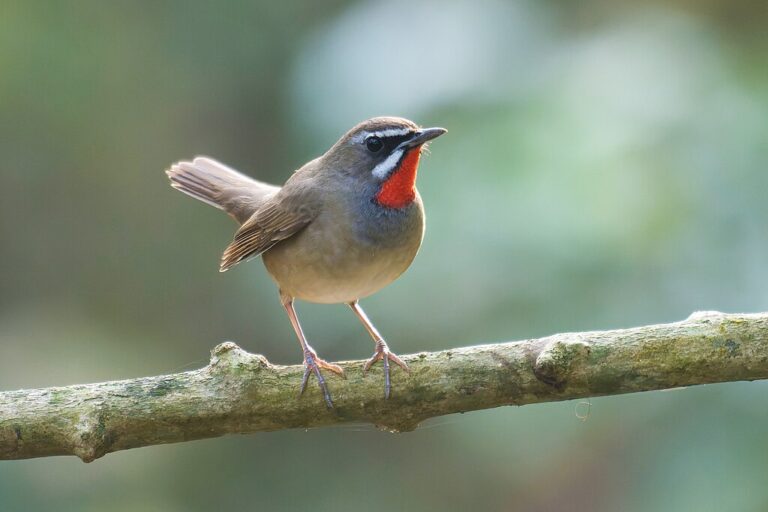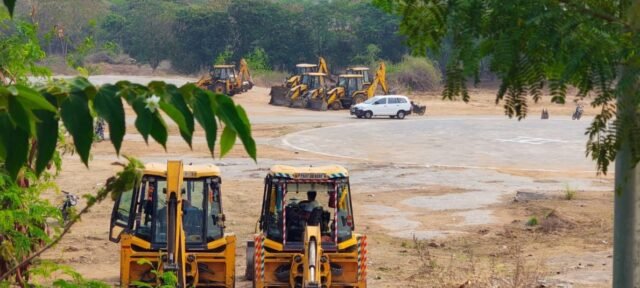- The Telangana government moots an eco-park in place of the University of Hyderabad, in response to growing protests against the auctioning of the Kancha Gachibowli Forest.
- As Hyderabad’s urban sprawl accelerates, the city’s shrinking forest areas cause concern for environmentally-conscious citizens.
- The ongoing protests by students and faculty prompted intervention from the Supreme Court to halt the government’s attempt to take over the forest patch.
With a Supreme Court order halting tree felling that has stalled the Telangana government plans to auction disputed forest land adjoining the University of Hyderabad, the state is now considering an ecopark in the area, even as citizen protests continue.
The Kancha Gachibowli Forest or KGF, an open natural ecosystem with a mix of dry deciduous and wet deciduous forests, savannah, scrubland, rocky outcrops and more, is one of the few lung spaces remaining around Hyderabad city. Last month, the state government’s announcement to auction 400 acres of the land in this area, was met with public protests. In response, the chief minister of Telangana, Anumula Revanth Reddy, said in the Assembly that KGF has “no deer, no tigers, but only a few ‘cunning foxes’ who were out to hinder the state’s development”, attempting to justify the hostile takeover of the land using earthmovers. This sparked the university students, faculty, and environmentalists to take it upon themselves to put a stop to the government’s blinkered approach to development. They protested, stopped the earthmovers from wreaking more havoc, were detained, and made the judiciary sit up and take notice of the systematic decimation of green cover in the city.
Taking cognisance of deforestation on the land, the Supreme Court, on April 3, passed an interim order staying the tree felling in the disputed area.
Now, in an unexpected move, government sources have informed Mongabay India that the ruling Congress government is considering building a 2,000-acre eco-forest park — potentially the world’s largest — on the land currently occupied by the University of Hyderabad, including Kancha Gachibowli. The proposed park, modelled after Central Park in the U.S., could house various wildlife species and has plans to invite global experts to design it and top academic figures to manage it. If the proposal moves forward, the eco-park will also feature the tallest observatory tower meant to enhance the experience. According to a government source, this initiative could solve the issue of losing green spaces while generating employment. The university would be relocated to the proposed Future City, envisioned as a net-zero greenfield smart city, spanning 30,000 acres.

However, protesting students and faculty find this solution absurd, even laughable. “Why not leave that patch of land as it is?” asks Akash Kumar, Vice President of the UoH Students’ Union, adding, “This is a natural forest, looked after by students from the beginning. They can protect it without turning it into a tourist spot that can be tampered with.”
Joby Joseph, a professor from the Centre for Neural and Cognitive Sciences, who has been birding for the last 14 years on the university campus, including in the Kancha Gachibowli area, points out that he has spotted 230 bird species, both migratory and resident, and photographed 200 of them in the area. “Many of them are found in the disputed area,” he shares. “In contrast, the Zoo Park (Nehru Zoological Park) in the city, which is the biggest park for wildlife here, has only 170 species of birds.”
Joseph lists various species such as night jars, yellow-wattled lapwings, ringed plovers, Eurasian wrynecks, larks, pipits, partridges, and many more. “At Kancha Gachibowli, the land slopes to a lake called Peacock Lake. Many migrant birds, such as Siberian ruby-throats, paddyfield warbler, many crakes, black bittern, and yellow bittern, are found here. Ducks used to frequent the area, but not anymore,” Joseph notes, pointing to the sewage that flows into the lake from surrounding buildings, which has contaminated the water. “I have also spotted many animals, such as star tortoises, porcupines, soft-shelled turtles, several types of snakes and insects, and monitor lizards,” he adds.


Hark back to history
The University of Hyderabad was established in 1973 as part of a six-point formula proposed by the then Prime Minister Indira Gandhi to address the growing Telangana movement for the separation of Telangana from the pre-existing state of Andhra Pradesh. The government allotted a large parcel of land (2300 acres) in Gachibowli, about 10 km from Hyderabad city, to establish the university. Over time, several land parcels were returned to the government to accommodate various public institutions, including a sports complex that hosted national games in 2002 and the inaugural Afro-Asian Games in 2003.
The dispute over Kancha Gachibowli, considered “poramboke” land (wasteland suitable only for grazing), dates back to the early 2000s during Chandrababu Naidu’s tenure as Chief Minister.
In a controversial move at that time, the state government entered into an agreement with IMG Bharata, led by Billy Rao, to sell 850 acres in Gachibowli and Mamidipally for sports academies. IMG Bharata was misleadingly presented as a subsidiary of the well-known IMG Academy in Florida.
After the 2004 change in government, the Congress-led administration annulled the agreement through the Andhra Pradesh Government Property (Preservation, Protection, and Resumption) Act of 2007, citing public interest. Billy Rao’s challenge in the Telangana High Court was unsuccessful, and his appeal to the Supreme Court was similarly dismissed. The 400 acres were subsequently handed over to the Telangana Government Industrial Infrastructure Corporation (TGIIC). The current protests began when the government decided to clear Kancha Gachibowli Forest for development projects. Akash Kumar argues that the government is exploiting a legal technicality (the lack of a title deed) to seize the land, while the government maintains that the land has always been its property.

Citizens take charge
This is arguably the biggest citizen-led environmental protest the state has witnessed in the recent past. Activists and academics Mongabay India spoke to shared that the city has grown exponentially, and protecting the city’s remaining urban forests is non-negotiable.
The HITEC City, a financial and technology hub, which helped put Hyderabad on the global map, was built in the late 90s on ancient rock formations, sparking concerns among environmentalists and historians. While it raised concerns, they were mostly isolated and did not solidify into a large-scale protest, as seen in this case.
Later, in 2019, when the National Highway Authority of India (NHAI) proposed axing close to 1,000 historic banyan trees that line the road from Hyderabad to Bijapur to make way for a four-lane highway, citizens rose in protest. The “Save Banyans of Chevella” protest saw citizens campaigning against the project relentlessly — they geotagged the trees to keep a vigil on them, held awareness camps, appealed to the authorities, and even got the National Green Tribunal (NGT) to stall the move. More recently, similar protest scenes played out when the state decided to give away 2,900 acres of land in Vikarabad’s Damagundam Reserve Forest for the establishment of the Indian Navy’s low-frequency radar station.
With the students of the university amplifying the need to save the Kancha Gachibowli Forest, the current protest has taken a more definite dimension. One of the demands that the students have put forward to agree to a discussion with the government is to allow them to go to the disputed land to survey and document the biodiversity in the area, in order to prepare a report on what the state stands to lose ecologically if the forest is auctioned off. “We have put forward three simple demands: pull out the police from the campus, release our fellow students in detention, drop FIRs against the students, and allow us to survey the region to prepare a report that we can submit to the Supreme Court. We are not ready for any negotiations with the government until these demands are met,” Kumar says.

In the meantime, the students and faculty remain clueless about the university administration’s stance on the imbroglio. “We have tried many times to discuss the issue with the management, but they have refused to meet us,” Kumar says, adding: “Last year, a patch of scrub land was exposed to afforestation by the government. We heard later that the government authorities mailed the registrar who accepted it, and the plantation was done by the time we got to know it.” Kumar emphasises that protecting the forest is difficult without help from the administration. “The student community does its best, but we cannot continuously monitor the large forest patch without dedicated efforts from the administration.”
Meanwhile, it is alleged that the forest patch remained grossly neglected until now, with students littering it, sewage flowing into the lake, and no attempt made to understand the biodiversity or actively conserve the area. Kumar, however, maintains that the student community cleans the patch time and again, but that isn’t enough. “The sewage comes from the housing societies adjacent to the lake. We have been pushing the administration to take action and put forward proposals to conserve the forest,” Kumar says.
Joseph, however, says that the beauty of Kancha Gachibowli lies in the lack of intervention. “I think it’s a good thing that there is minimal human intervention there,” he says. The forest is wild, and he hopes it remains that way.
For now, the matter is with the judiciary and a decision is awaited this month on the status of the takeover.
Read more: Creating urban biodiversity parks from degraded lands
Banner image: In what was arguably the biggest citizen-led environmental protest Telangana has witnessed in the recent past, university students, faculty, and environmentalists protested and stopped bulldozers from razing down Kancha Gachibowli. Image by special arrangement.








